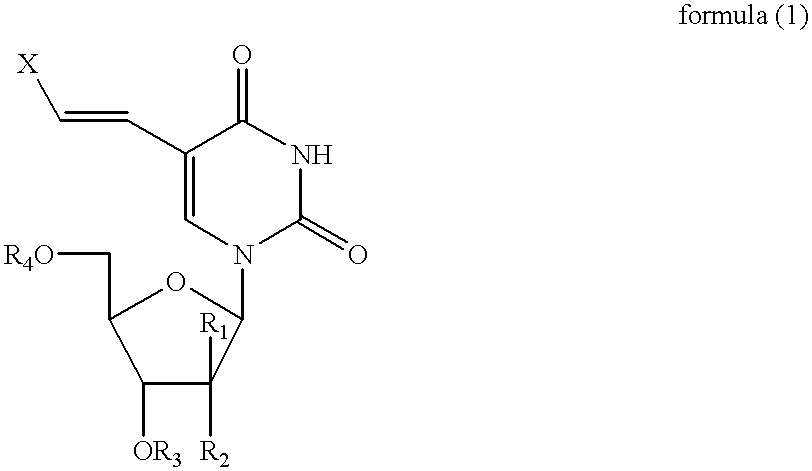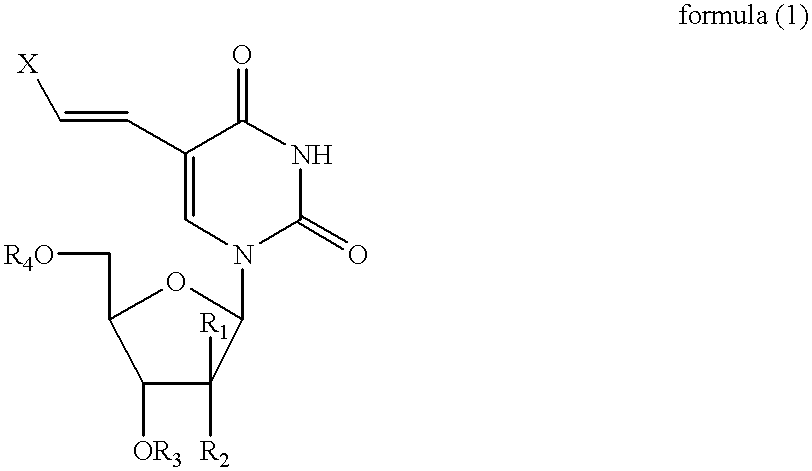Combined use of nucleoside analogues and gene transfection for tissue imaging and therapy
- Summary
- Abstract
- Description
- Claims
- Application Information
AI Technical Summary
Benefits of technology
Problems solved by technology
Method used
Image
Examples
example 2
[0132] The related (E)-5-(2-iodovinyl)-2'-fluoro-2-deoxyarabinouridine (IVFAU), (E)-5-(2-iodovinyl)arabinouridine (IVAU), and (E)-5-(2-iodovinyl)-2'-deoxyuridine (1VDU) compounds have been prepared, using a procedure similar to that used in Example 1, as illustrated in the schematic for Example 2 shown below using an equivalent quantity of the (E)-5-iodouracil nucleoside of formula (2), in place of (E)-5-iodo-2'-fluoro-2'-deoxyuridine in Example 1, to afford IVFAU, IVAU and IVDU which had melting points of 176-178.degree. C., 171-175.degree. C. and 166-170.degree. C., respectively. 12
example 3
[0133] Carrier Added Synthesis of [.sup.131I]-(E)-5-(2-iodovinyl)-2'-fluor-o-2'-deoxyuridine {[.sup.131I-IVFRU}
[0134] (See Schematic Presentation Following Example)
[0135] A solution of [.sup.131I]-Nal (74 MBq) in 0.1 N NaOH (5 .mu.L) was placed in a Wheaton vial and then a solution of ICI (124 .mu.g, 0.765 .mu.mol) in acetic acid-acetonitrile (1:4, v / v; 10 .mu.L) was added. A solution of (E)-5-(2-trimethylsilylvinyl)-2'-fluoro-2'-deoxyuridine (500 .mu.g, 1.53 .mu.mol) in acetic acid-acetonitrile (1:4, v / v, 10 .mu.L) was then added to the contents in the Wheaton vial and the reaction was allowed to proceed for 15 min at 25.degree. C. The product was purified by preparative reverse phase HPLC using a Whatman Partisil M9 10 / 25 C8 column by isocratic elution with acetonitrile-water (70:30, v / v) at a flow rate of 1.5 MI / min. The product [.sup.131I]-IVFRU had a retention time of 11.76 min under these conditions whereas unreacted (E)-5-(2-trimethylsilylvinyl)-2'-fluoro-2'-deoxyuridine had ...
example 4
[0136] No Carrier Added Synthesis of [.sup.131I]-(E)-5-(2-iodovinyl)-2'-fl-uoro-2'-deoxyuridine {[.sup.131I]-IVFRU}
[0137] (See Schematic Presentation Following Example)
[0138] A solution of (E)-5-(2-trimethylsilylvinyl)-2'-fluoro-2'-deoxyuridi-ne (100 .mu.g, 0.306 .mu.mol) in acetic acid-acetonitrile (1:4, v / v, 10 .mu.L) was added to a solution of [.sup.131I]-Nal (11.3 Mbq) in 0. 1 N NaOH (5 .mu.L) in a Wheaton vial. A solution of N-chlorosuccinimide (100 .mu.g, 0.749 .mu.mol) in acetic acid-acetonitrile (1:4, v / v, 10 .mu.L) was then added, the reaction was allowed to proceed for 30 min at 25.degree. C., and the reaction was terminated by the addition of sodium thiosulfate (100 .mu.g, 0.632 .mu.mol) in water (10 .mu.L). The reaction mixture was separated by HPLC using the procedure described in Example 3 to afford [.sup.131I]-(E)-5-(2-iodovinyl)-2'-fluoro-2'-deoxyuridine (8.0 Mbq, 71% radiochemical yield, >98% radiochemical purity, specific activity >5.29 TBq / mmol) as a no carrier ad...
PUM
| Property | Measurement | Unit |
|---|---|---|
| Time | aaaaa | aaaaa |
| Time | aaaaa | aaaaa |
| Time | aaaaa | aaaaa |
Abstract
Description
Claims
Application Information
 Login to View More
Login to View More - R&D
- Intellectual Property
- Life Sciences
- Materials
- Tech Scout
- Unparalleled Data Quality
- Higher Quality Content
- 60% Fewer Hallucinations
Browse by: Latest US Patents, China's latest patents, Technical Efficacy Thesaurus, Application Domain, Technology Topic, Popular Technical Reports.
© 2025 PatSnap. All rights reserved.Legal|Privacy policy|Modern Slavery Act Transparency Statement|Sitemap|About US| Contact US: help@patsnap.com



